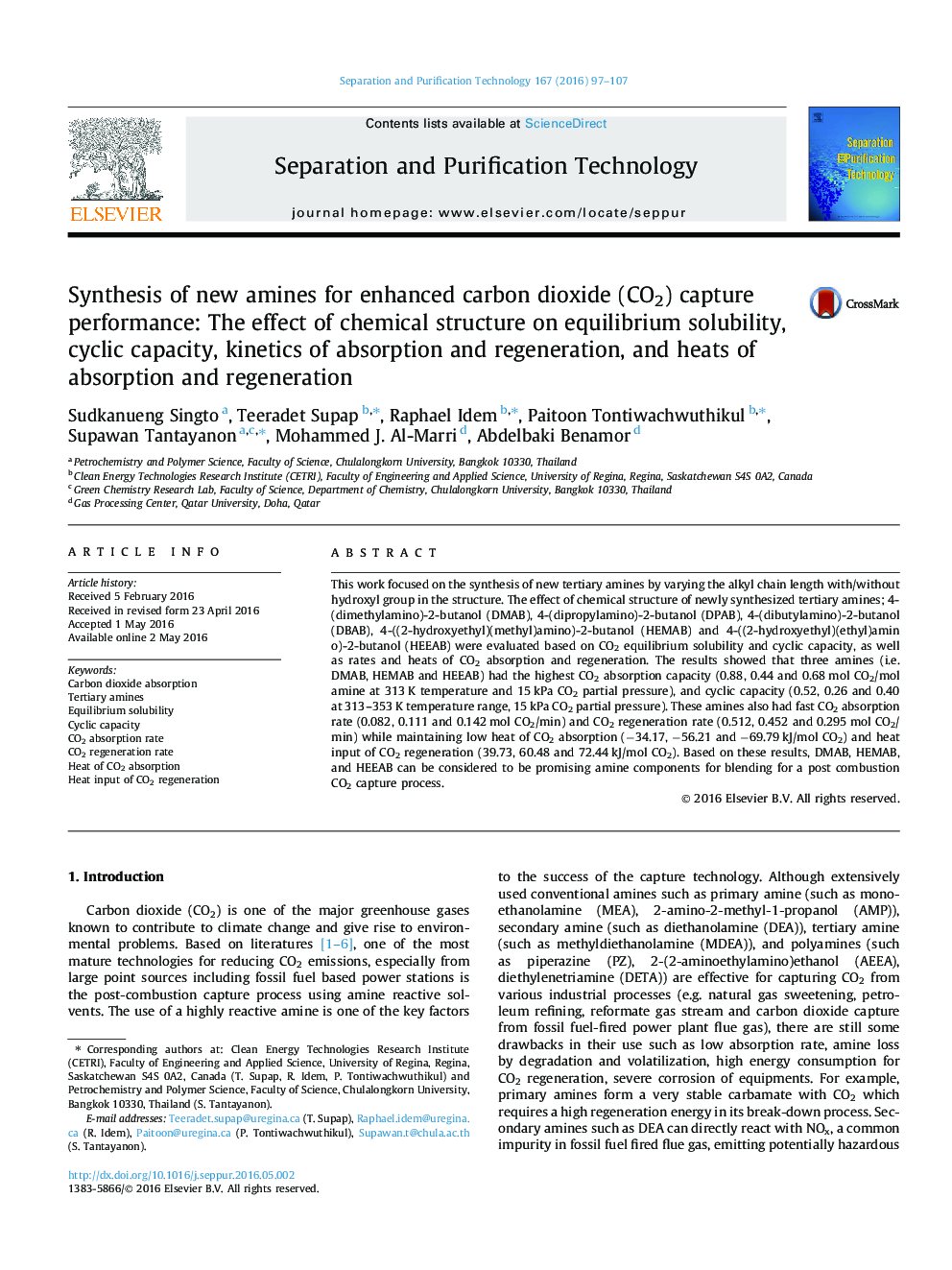| Article ID | Journal | Published Year | Pages | File Type |
|---|---|---|---|---|
| 639859 | Separation and Purification Technology | 2016 | 11 Pages |
•This work focused on the synthesis of newly created amines by varying the alkyl chain length with/without hydroxyl group in the structure.•The effect of chemical structure of newly synthesized tertiary amines; 4-(dimethylamino)-2-butanol (DMAB), 4-(dipropylamino)-2-butanol (DPAB), 4-(dibutylamino)-2-butanol (DBAB), 4-((2-hydroxyethyl)(methyl)amino)-2-butanol (HEMAB) and 4-((2-hydroxyethyl)(ethyl)amino)-2-butanol (HEEAB) were evaluated based on CO2 equilibrium solubility and cyclic capacity, as well as rates and heats of CO2 absorption and regeneration.•The results showed that these three amines had the highest CO2 absorption capacity (0.88, 0.44 and 0.68 mol CO2/mol amine at 313 K temperature and 15 kPa CO2 partial pressure), and cyclic capacity (0.52, 0.26 and 0.40 at 313–353 K temperature range, 15 kPa CO2 partial pressure).•They also had fast CO2 absorption rate (0.082, 0.111 and 0.142 mol CO2/min) and CO2 regeneration rate (0.512, 0.452 and 0.295 mol CO2/min) while maintaining low heat of CO2 absorption (−34.17, −56.21 and −69.79 kJ/mol CO2) and heat input of CO2 regeneration (39.73, 60.48 and 72.44 kJ/mol CO2).•Based on these results, DMAB, HEMAB, and HEEAB can be considered to be promising amine components for blending for the next generation post-combustion CO2 capture processes.
This work focused on the synthesis of new tertiary amines by varying the alkyl chain length with/without hydroxyl group in the structure. The effect of chemical structure of newly synthesized tertiary amines; 4-(dimethylamino)-2-butanol (DMAB), 4-(dipropylamino)-2-butanol (DPAB), 4-(dibutylamino)-2-butanol (DBAB), 4-((2-hydroxyethyl)(methyl)amino)-2-butanol (HEMAB) and 4-((2-hydroxyethyl)(ethyl)amino)-2-butanol (HEEAB) were evaluated based on CO2 equilibrium solubility and cyclic capacity, as well as rates and heats of CO2 absorption and regeneration. The results showed that three amines (i.e. DMAB, HEMAB and HEEAB) had the highest CO2 absorption capacity (0.88, 0.44 and 0.68 mol CO2/mol amine at 313 K temperature and 15 kPa CO2 partial pressure), and cyclic capacity (0.52, 0.26 and 0.40 at 313–353 K temperature range, 15 kPa CO2 partial pressure). These amines also had fast CO2 absorption rate (0.082, 0.111 and 0.142 mol CO2/min) and CO2 regeneration rate (0.512, 0.452 and 0.295 mol CO2/min) while maintaining low heat of CO2 absorption (−34.17, −56.21 and −69.79 kJ/mol CO2) and heat input of CO2 regeneration (39.73, 60.48 and 72.44 kJ/mol CO2). Based on these results, DMAB, HEMAB, and HEEAB can be considered to be promising amine components for blending for a post combustion CO2 capture process.
